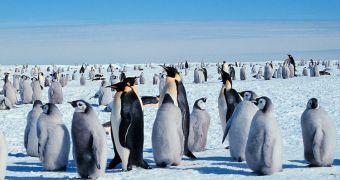Using high-resolution imaging capabilities aboard satellites in Earth's orbit, researchers were able to determine in a new study that Antarctica holds twice as many emperor penguins as initially thought.
The investigation was the first to demonstrate that it may be possible for biologists to conduct a census of various species and populations remotely. For this particular study, experts used satellite mapping technologies to image penguin colonies.
Satellites may from now on be used to figure out how the encroaching influence of global warming is changing Antarctic habitats, and how these changes are affecting large numbers of species occupying these areas, Astrobiology Magazine reports.
The study was carried out by a collaboration of researchers including experts from the British Antarctic Survey (BAS) and the University of Minnesota Polar Geospatial Center (PGC). The study is published in the latest issue of the open-access, peer-reviewed journal PLoS ONE.
The science group reveals that it used Very High Resolution (VHR) satellite images for this work. The resolution of images was further increased through the use of a technique called pan-sharpening. Thanks to this approach, they were able to differentiate between ice, penguins, shadows and feces.
“We are delighted to be able to locate and identify such a large number of emperor penguins. We counted 595,000 birds, which is almost double the previous estimates of 270,000 to 350,000 birds. This is the first comprehensive census of a species taken from space,” Peter Fretwel explains.
The expert, a BAS geographer, was the lead author of the paper. The British Antarctic Survey is sponsored by the Natural Environment Research Council (NERC), in the United Kingdom.
Emperor penguins are easier to spot than other penguin species because of their black-on-white color scheme, which makes them stand out from the white background provided by Antarctic snow. In total, experts analyzed 44 colonies, out of which 7 had not been previously observed.
“The methods we used are an enormous step forward in Antarctic ecology because we can conduct research safely and efficiently with little environmental impact, and determine estimates of an entire penguin population,” study coauthor Michelle LaRue explains.
The expert is based at the PGC. The organization is funded by the US National Science Foundation.

 14 DAY TRIAL //
14 DAY TRIAL //